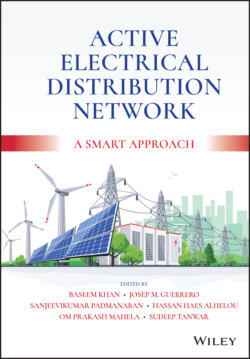Читать книгу Active Electrical Distribution Network - Группа авторов - Страница 44
2.3 Indian Experiences with Agriculture Feeder Segregation
ОглавлениеIndia is the world pioneer for the process of feeder segregation, especially in the area of creating a dedicated feeder for the agriculture sector. The process of feeder segregation in India has been initiated since 1996 but has been effective since 2013 by projecting the process of feeder segregation as a national-level scheme. The main objectives of this scheme are to guide, monitor, finance, and promote the process of feeder segregation in different agricultural-intensive Indian states. The scheme is included under Deen Dayal Upadhyay Gram Jyoti Yojana (DDUGJY) and a total cost of Rs. 4303.3 million has been approved to use in December 2014 to separate the agricultural and non-agricultural feeders. The process of feeder segregation was implemented by the state of Punjab for the first time in India in 1996–1997 and was executed on a turnkey basis in 2003–2004 [6]. In line with the state of Punjab, Gujarat opted for feeder segregation through Jyoti Gram Yojna. As an initiation towards feeder segregation, different pilot projects were being implemented by Andhra Pradesh in 2010. Growing trends and the benefits of feeder segregation has motivated many other Indian states, such as Karnataka, Uttar Pradesh, Bihar, Haryana, Rajasthan, Maharashtra, and Madhya Pradesh.
The concept of feeder segregation in India is familiar only among the utilities population, especially those working on the feeder segregation projects. Other technical experts as well as academicians have not taken any initiative to understand the concept of feeder segregation and hence to carry out the research and development activities in this domain. Hence, the research status in this area is negligible. Although some agencies like World Bank, Power Line (ABB), and some government agencies have been involved in publishing some studies upon feeder segregation, their studies have been limited to the status of implementation of this plan, the budget involved, and the associated challenges with feeder segregation. However, many Indian researchers have become involved in the research area of network reconfiguration, which has been considered to be one of the important techniques to deal with the issues lying with feeder segregation. Details of some of the contributions of Indian researchers in this area are now given. Goswami et al. [31] proposed the feeder reconfiguration of distribution system for loss minimization. This work reports a power flow based heuristic algorithm for determining the minimum loss configuration of radial distribution networks. The algorithm is based on the concept of the optimum flow pattern, which is determined by solving the KVL and KCL (Kirchhoff’s voltage and current laws) equations of the network. Niknam et al. [32] developed a hybrid evolutionary algorithm for distribution feeder reconfiguration. This algorithm presents a new method to reduce the distribution system loss by feeder reconfigurations. This new method combines the self-adaptive particle swarm optimization (SAPSO) with the shuffled frog-leaping algorithm (SFLA) in an attempt to find global optimal solutions for the distribution feeder reconfiguration (DFR).
Increasing requirements of urbanization, industrialization, and modernization demands further expansion and development of the national power grid and, nonetheless, with a better efficiency and an enhanced voltage stability. To satisfy the above objective, Nath et al. [33] have verified a network reconfiguration as an effective and suitable method. A fuzzy multiobjective approach for network reconfiguration of distribution systems has been proposed by Das [16]. This work presents an algorithm for network reconfiguration based on the heuristic rules and fuzzy multiobjective approach. Multiple objectives are considered for load balancing among the feeders and also to minimize the real power loss, deviation of node voltage, and branch current constraint violation, while being subject to a radial network structure in which all loads must be energized. Ahuja et al. [12] proposed an AIS-ACO hybrid approach for a multiobjective distribution system reconfiguration. This proposes a hybrid algorithm based on artificial immune systems and an ant colony optimization trick for distribution system reconfiguration, which is formulated as a multiobjective optimization problem. Kalambe et al. [34] presented loss minimization techniques in a distribution network, a bibliographical survey that describes the three main techniques of loss minimization that includes network reconfiguration. Karthikeyan et al. [35] has proposed a novel criterion for segregating the feeder with a proposal based on the slope of the curve between the feeder losses versus the receiving end voltage. Application of this criterion results in the most minimal loss configuration for any given loading condition. An existing switching indices criterion and a switching algorithm criterion have been considered and the results are compared with that of the proposed slope criterion, which results in the most minimal loss configuration.
